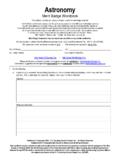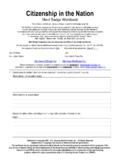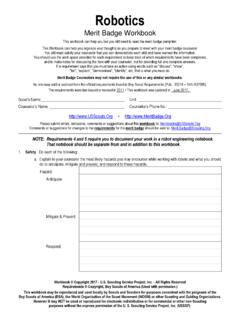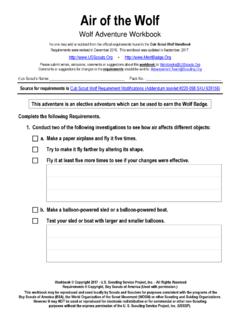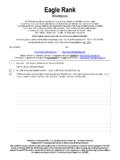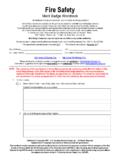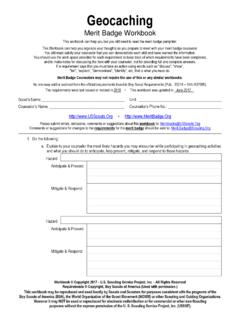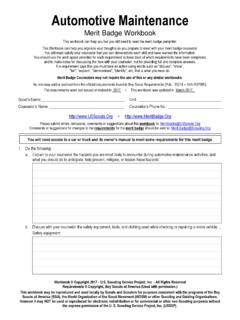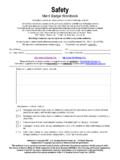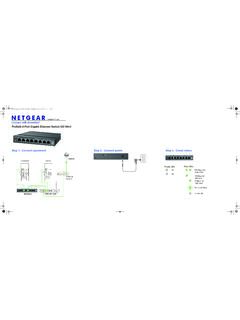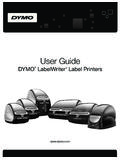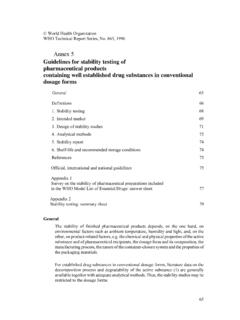Transcription of Re ptile and A m phibian Stu dy - usscouts.org
1 Reptile and Amphibian StudyMerit Badge WorkbookThis workbook can help you but you still need to read the merit badge Workbook can help you organize your thoughts as you prepare to meet with your merit badge still must satisfy your counselor that you can demonstrate each skill and have learned the should use the work space provided for each requirement to keep track of which requirements have been completed,and to make notes for discussing the item with your counselor, not for providing full and complete a requirement says that you must take an action using words such as "discuss", "show","tell", "explain", "demonstrate", "identify", etc, that is what you must Badge Counselors may not require the use of this or any similar one may add or subtract from the official requirements found in Scouts BSA Requirements (Pub. 33216 SKU 653801).The requirements were last issued or revised in 2019 This workbook was updated in October s Name: _____ Unit: _____Counselor s Name: _____ Phone No.
2 : _____ Email: _____ submit errors, omissions, comments or suggestions about this workbook to: or suggestions for changes to the requirements for the merit badge should be sent to: Describe the identifying characteristics of six species of reptiles and four species of amphibians found in the United any four of these, make sketches from your own observations or take photographs. Show markings, color patterns, orother characteristics that are important in the identification of each of the four species. Discuss the habits and habitats of allten CharacteristicsHabits:Habitat:Workbook Copyright 2020 - Scouting Service Project, Inc. - All Rights ReservedRequirements Copyright, Boy Scouts of America (Used with permission.)This workbook may be reproduced and used locally by Scouts and Scouters for purposes consistent with the programs of theBoy Scouts of America (BSA), the World Organization of the Scout Movement (WOSM) or other Scouting and Guiding it may NOT be used or reproduced for electronic redistribution or for commercial or other non-Scoutingpurposes without the express permission of the U.
3 S. Scouting Service Project, Inc. (USSSP).Reptile and Amphibian Study Scout's Name: _____SpeciesIdentifying CharacteristicsHabits:Habitat:SpeciesIde ntifying CharacteristicsHabits:Habitat:SpeciesIde ntifying CharacteristicsHabits:Habitat:Reptile and Amphibian Study - Merit Badge Workbook Page. 2 of 16 Reptile and Amphibian Study Scout's Name: _____SpeciesIdentifying CharacteristicsHabits:Habitat:SpeciesIde ntifying CharacteristicsHabits:Habitat:Amphibians SpeciesIdentifying CharacteristicsHabits:Habitat:Reptile and Amphibian Study - Merit Badge Workbook Page. 3 of 16 Reptile and Amphibian Study Scout's Name: _____SpeciesIdentifying CharacteristicsHabits:Habitat:SpeciesIde ntifying CharacteristicsHabits:Habitat:SpeciesIde ntifying CharacteristicsHabits:Habitat:Reptile and Amphibian Study - Merit Badge Workbook Page. 4 of 16 Reptile and Amphibian Study Scout's Name: _____For any four of these, make sketches from your own observations or take photographs.
4 Show markings, color patterns, orother characteristics that are important in the identification of each of the four 23 4 Reptile and Amphibian Study - Merit Badge Workbook Page. 5 of 16 Reptile and Amphibian Study Scout's Name: _____2. Discuss with your merit badge counselor the approximate number of species and general geographic distribution of reptilesand amphibians in the United a list of the most common species found in your local area or and Amphibian Study - Merit Badge Workbook Page. 6 of 16 Reptile and Amphibian Study Scout's Name: _____3. Describe the main differences between:Amphibians and and and and and Explain how reptiles and amphibians are an important component of the natural and Amphibian Study - Merit Badge Workbook Page. 7 of 16 Reptile and Amphibian Study Scout's Name: _____List four species that are officially protected by the federal government or state you live in, and tell why each is three species of reptiles and three species of amphibians found in your local area that are not protected.
5 Discuss thefood habits of all ten Species1. SpeciesWhy protected?Food habits:2. SpeciesWhy protected?Food habits:3. SpeciesWhy protected?Food habits:Reptile and Amphibian Study - Merit Badge Workbook Page. 8 of 16 Reptile and Amphibian Study Scout's Name: _____4. SpeciesWhy protected?Food habits:Unprotected Reptiles1. SpeciesFood habits:2. SpeciesFood habits:3. SpeciesFood habits:Unprotected Amphibians1. SpeciesFood habits:Reptile and Amphibian Study - Merit Badge Workbook Page. 9 of 16 Reptile and Amphibian Study Scout's Name: _____2. SpeciesFood habits:3. SpeciesFood habits:5. Describe how reptiles and amphibians From observation, describe how snakes move the functions of the muscles, ribs, and belly and Amphibian Study - Merit Badge Workbook Page. 10 of 16 Reptile and Amphibian Study Scout's Name: _____7. Describe in detail six venomous snakes and the one venomous lizard found in the United States. Describe their habits andgeographic Snake 1 Description:Habits:Range:Venomous Snake 2 Description:Habits:Range:Venomous Snake 3 Description:Habits:Range:Reptile and Amphibian Study - Merit Badge Workbook Page.
6 11 of 16 Reptile and Amphibian Study Scout's Name: _____Venomous Snake 4 Description:Habits:Range:Venomous Snake 5 Description:Habits:Range:Venomous Snake 6 Description:Habits:Range:Reptile and Amphibian Study - Merit Badge Workbook Page. 12 of 16 Reptile and Amphibian Study Scout's Name: _____Venomous LizardDescription:Habits:Range:Tell what you should do in case of a bite by a venomous Do ONE of the following:c a. Maintain one or more reptiles or amphibians for at least a month. Record the food accepted, eating methods, changes incoloration, shedding of skins, and general habits; or keep the eggs of a reptile from the time of laying until hatching; orkeep the eggs of an amphibian from the time of laying until their transformation into tadpoles (frogs) or larvae(salamanders). Whichever you chose, keep records of and report to your counselor how you cared for youranimal/eggs/larvae to include lighting, habitat, temperature and humidity maintenance, and any veterinary carerequirements.
7 (See the note on page 15 regarding this requirement.)Reptile(s) or Amphibian(s) Maintained:Dates:Day Food Accepted Eating MethodsReptile and Amphibian Study - Merit Badge Workbook Page. 13 of 16 Color ChangesSkin SheddingGeneral Habits12345678 Reptile and Amphibian Study Scout's Name: _____91011121314151617181920212223242526 2728293031c b. Choose a reptile or amphibian that you can observe at a local zoo, aquarium, nature center, or other such exhibit (such asyour classroom or school). Study the specimen weekly for a period of three months. At each visit, sketch the specimenin its captive habitat and note any changes in its coloration, shedding of skins, and general habits and behavior. Discusswith your counselor how the animal you observed was cared for to include its housing and habitat, how the lighting,temperature, and humidity were maintained, and any veterinary care requirements.(Note: Make your sketches on separate pages and attach them to the workbook.)
8 Reptile and Amphibian Study - Merit Badge Workbook Page. 14 of 16 Reptile and Amphibian Study Scout's Name: _____Find out, either from information you locate on your own or by talking to the caretaker, what this species eats and whatare its native habitat and home range, preferred climate, average life expectancy, and natural predators. Also identify anyhuman caused threats to its population and any laws that protect the species and its habitat. After the observation period,share what you have learned with your Do TWO of the following:c a. Identify at night three kinds of toads or frogs by their voices. Imitate the song of each for your counselor. Stalk each witha flashlight and discover how each sings and from b. Identify by sight eight species of reptiles or c. Using visual aids, give a brief talk to a small group on three different reptiles and and Amphibian Study - Merit Badge Workbook Page. 15 of 16 When working on merit badges, Scouts and Scouters should be aware of some vital information in the current edition ofthe Guide to Advancement (BSA publication 33088).
9 Important excerpts from that publication can be downloaded can download a complete copy of the Guide to Advancement from and Amphibian Study Scout's Name: _____10. Give five superstitions about reptiles and amphibians and a correct explanation for seven examples of unusual behavior or other true facts about reptiles and : Scouts must not use venomous reptiles in fulfilling requirement 8a. Species listed by federal or state law as endangered,protected, or threatened must not be used as live specimens in completing requirement 8a. When you decide keeping your specimen isno longer possible or desired, be sure to find another appropriate home for it or return it to the wild at the location of capture. Checkwith your merit badge counselor for those instances where the return of these specimens would not be the Endangered Species Act of 1973, some plants and animals are, or may be, protected by federal law. The same ones and/orothers may be protected by state law.
10 Be sure that you do not collect protected state may require that you purchase and carry a license to collect certain species. Check with the wildlife and fish and gameofficials in your state regarding species regulations before you begin to and Amphibian Study - Merit Badge Workbook Page. 16 of 16
